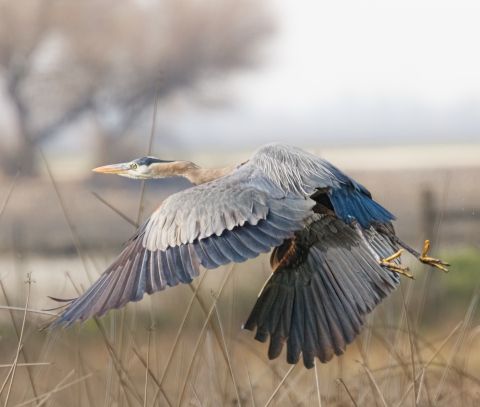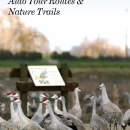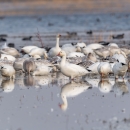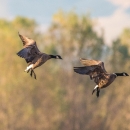Visit Us
National wildlife refuges offer us all a chance to unplug from the stresses of daily life and reconnect with our natural surroundings. The refuge offers visitors over 15 miles of auto tour routes and more than 10 miles of nature trails that lead through each of our major habitat types – wetlands, uplands, grasslands, riparian riparian
Definition of riparian habitat or riparian areas.
Learn more about riparian woodlands, alkali sinks, and vernal pools. These features allow visitors to get close to the sights and sounds of the diverse wildlife species that live here. Birds, mammals, reptiles, amphibians, fish, insects, and native plants – they are all here and chances are one or more of our auto tour routes and nature trails will allow you to see or hear the majority of them.
Conditions change from season to season in these habitats, so the species you might see will also change. While many bird species are year-round residents, most birds are seasonal and can only be observed during specific times of the year. Other bird species pass through for a few short weeks during fall or spring migration. Just as the birds change with the seasons, so do the landscapes. Early spring wildflowers give way to summer grasses, and even certain insect species you may not have noticed in the spring become very apparent in the fall such as various dragonfly species. During the hot dry days of summer, you are more likely to see a greater number of bird species in the morning – the next best time for summer birds is in the late afternoon/early evening. Likewise, most mammals, including the tule elk, are more likely to be visible in the morning or early evening during the hot months.
There is always something to see at the refuge, but certain times are better than others and the cast of nature’s characters changes with the seasons. The spectacular concentrations of waterfowl and sandhill cranes occur during autumn through spring. No matter when you visit, bring your binoculars, camera – and your curiosity! There is no fee to visit the visitor center, auto tour routes, and nature trails.
The San Luis NWR Complex Visitor Center and Headquarters, located on the San Luis NWR includes an exhibit hall with interactive educational exhibits about wildlife and habitats, tule elk viewing, a multi-purpose room to hold conservation meetings and conduct environmental education programs for schools, and is the administrative headquarters for the complex. The visitor center complements the wildlife refuges of California’s San Joaquin Valley and provides a focal point for visitors, and a launching point to explore the entire refuge complex. The facility was designed for environmental sustainability and energy efficiency and was awarded a Platinum rating under the Leadership in Energy and Environmental Design program (LEED). The Visitor Center may be open for extended hours seasonally, but it is open daily from 8:00 a.m. to 4:30 p.m. except holidays.
Tips for an enjoyable visit
Dress appropriately for the seasons. Comfortable walking shoes are recommended for nature trails. Summer months can reach extreme temperatures of over 100 degrees for weeks at a time. Always bring and carry plenty of water. Hats and sunscreen are highly recommended. Mosquitoes can be very active, especially during fall and spring. Mosquito repellant is recommended. Binoculars and a camera will help you get the most of your visit.
During the hot dry days of summer, you are more likely to see a greater number of bird species in the morning – the next best time for summer birds is in the late afternoon/early evening. Likewise, most mammals, including the tule elk, are more likely to be visible in the morning or early evening during the hot months.
If you have 15-minutes: Enjoy a relaxing stroll on the Wetland nature trail accessed outside the visitor center.
If you have one hour: Explore the exhibits inside the visitor center and then travel either the Tule Elk or Waterfowl auto tour route.
If you have half a day or more: Explore the exhibits inside the visitor center and then travel both the Tule Elk and Waterfowl auto tour routes. Enjoy a walk on either the Sousa Marsh or Wetland nature trails. Bring a picnic lunch to eat under the picnic shelter outside the visitor center.
Visitor Center
Let our staff at the visitor center help you plan your visit! This is a great starting point for visitors to become more familiar with the refuge and the wildlife that live here. Staff will provide seasonal wildlife viewing tips and information about recent sightings to help you get the most of your visit. The visitor center features an interactive exhibit hall with informative and educational displays about the refuge. The visitor center serves as the ideal launching point to explore the auto tour routes and nature trails.
Activities
Trails
The refuge features 8 nature trails encompassing over 10 miles. Nature trails are open to foot traffic only. Please stay on trails, except at special areas where leaving the trail is allowed and indicated by signage. Dogs are allowed on nature trails, but must be on a leash and under control at all times. Please read our HIKING page for descriptions of each trail.
Related Documents
The Auto Tour and Nature Trail brochure features maps and information about the refuge auto tour routes and trails. Visit the "Library" page to download all of our brochures, including bird and mammal lists.
Other Facilities in the Complex
The San Luis NWR is part of the San Luis NWR Complex. A national wildlife refuge national wildlife refuge
A national wildlife refuge is typically a contiguous area of land and water managed by the U.S. Fish and Wildlife Service for the conservation and, where appropriate, restoration of fish, wildlife and plant resources and their habitats for the benefit of present and future generations of Americans.
Learn more about national wildlife refuge complex is an administrative grouping of two or more refuges, wildlife management areas or other refuge conservation areas that are primarily managed from a central office location. Refuges are grouped into a complex structure structure
Something temporarily or permanently constructed, built, or placed; and constructed of natural or manufactured parts including, but not limited to, a building, shed, cabin, porch, bridge, walkway, stair steps, sign, landing, platform, dock, rack, fence, telecommunication device, antennae, fish cleaning table, satellite dish/mount, or well head.
Learn more about structure because they occur in a similar ecological region, such as a watershed or specific habitat type, and have a related purpose and management needs. Typically, a project leader or complex manager oversees the general management of all refuges within the complex and refuge managers are responsible for operations at specific refuges. Supporting staff, composed of administrative, law enforcement, refuge manager, biological, fire, visitor services, and maintenance professionals, are centrally located and support all refuges within the complex.
Other units in the San Luis NWR Complex include the Merced NWR, San Joaquin River NWR, and Grasslands Wildlife Management Area.
Rules and Policies
On national wildlife refuges, WILDLIFE COMES FIRST! All areas of the refuges are closed to public entry unless explicitly posted as an auto tour route, nature trail, fishing area, or parking lot. Please observe all “Area Closed” signs and do not travel beyond them in a vehicle or by foot. Visitors must comply with all posted rules and regulations. The refuge is open daily from ½-hour before sunrise to ½-hour after sunset. Auto tour routes are for vehicles only; walking is not allowed on auto tour routes. Explore one of the nature trails to enjoy the refuge by foot.
Locations
















The San Luis NWR Complex Visitor Center and Headquarters located on the San Luis NWR includes an exhibit hall with interactive educational exhibits about wildlife and habitats, tule elk viewing, a multi-purpose room to hold conservation meetings and conduct environmental education programs for schools, and is the administrative headquarters for the refuge complex. The visitor center complements the wildlife refuges of California’s San Joaquin Valley and provides a focal point for visitors, and a launching point to explore the entire refuge complex. The facility was designed for environmental sustainability and energy efficiency and was awarded a Platinum rating under the Leadership in Energy and Environmental Design program (LEED), and strives to produce all energy used by the facility via banks of solar panels. The visitor center serves as a great starting point during your visit to become oriented and learn about what to see and do on the refuge.
Coming from the North (Modesto) on CA-99: In Turlock, take the Lander Ave/CA-165 exit toward Los Banos. Travel south on CA-165 through the communities of Hilmar and Stevinson. At the 4-way stop at the intersection of CA-165 and CA-140, continue southbound (straight) toward Los Banos for 12.5 miles. Turn left on Wolfsen Road. Follow Wolfsen Road approximately 2 miles until the pavement ends at the Refuge entrance. Continue through the gate on the gravel road and follow the signs to the Elk and Waterfowl auto tour routes. The Visitor Center is on the left immediately after passing through main entrance.
Coming from the South (Fresno) on CA-99: Travel on CA-99 north to CA-152 westbound. Travel westbound on CA-152 to Los Banos. Turn right on Mercey Springs Road (fourth stoplight after entering Los Banos from the east). Continue on Mercey Springs Road (also called CA-165) for approximately 6.5 miles to Wolfsen Road. Turn right onto Wolfsen Road. Follow Wolfsen Road approximately 2 miles until the pavement ends at the Refuge entrance. Continue through the gate on the gravel road and follow the signs to the Elk and Waterfowl auto tour routes. The Visitor Center is on the left immediately after passing through main entrance.
From Interstate 5 (north or south): Take the Los Banos/CA-152 east exit. Travel on CA-152 eastbound into Los Banos. Turn left on Mercey Springs Road. Continue on Mercey Springs Road (also called CA-165) for approximately 6.5 miles to Wolfsen Road. Turn right onto Wolfsen Road. Follow Wolfsen Road approximately 2 miles until the pavement ends at the Refuge entrance. Continue through the gate on the gravel road and follow the signs to the Elk and Waterfowl auto tour routes. The Visitor Center is on the left immediately after passing through the main entrance.
From San Francisco International Airport (SFO) and San Jose International Airport (SJC): Take US 101 southbound toward Gilroy. Take the CA-152 EAST exit toward Los Banos. Travel eastbound on CA-152 toward Los Banos. Continue into Los Banos and turn left on Mercey Springs Road. Continue on Mercey Springs Road (also called CA-165) for approximately 6.5 miles to Wolfsen Road. Turn right onto Wolfsen Road. Follow Wolfsen Road approximately 2 miles until the pavement ends at the Refuge entrance. Continue through the gate on the gravel road and follow the signs to the Elk and Waterfowl auto tour routes. The Visitor Center is on the left immediately after passing through the main entrance.
Physical address (do not use for mail):
7376 S. Wolfsen Road, Los Banos, CA 93635 (Note: In many GPS navigation units, this address will erroneously indicate to stop approximately 1 mile short of the refuge entrance. Continue on Wolfsen Rd all the way until it ends at the refuge entrance.)











This is the main entrance for the San Luis NWR and the access point to visit the visitor center/headquarters, Tule Elk auto tour route, Waterfowl auto tour route, and associated nature trails. Auto tour routes and nature trails are open daily year-round from 1/2-hour before sunrise to 1/2-hour after sunset.
Coming from the North (Modesto) on CA-99: In Turlock, take the Lander Ave/CA-165 exit toward Los Banos. Travel south on CA-165 through the communities of Hilmar and Stevinson. At the 4-way stop at the intersection of CA-165 and CA-140, continue southbound (straight) toward Los Banos for 12.5 miles. Turn left on Wolfsen Road. Follow Wolfsen Road approximately 2 miles until the pavement ends at the Refuge entrance. Continue through the gate on the gravel road and follow the signs to the Elk and Waterfowl auto tour routes. The Visitor Center is on the left immediately after passing through main entrance.
Coming from the South (Fresno) on CA-99: Travel on CA-99 north to CA-152 westbound. Travel westbound on CA-152 to Los Banos. Turn right on Mercey Springs Road (fourth stoplight after entering Los Banos from the east). Continue on Mercey Springs Road (also called CA-165) for approximately 6.5 miles to Wolfsen Road. Turn right onto Wolfsen Road. Follow Wolfsen Road approximately 2 miles until the pavement ends at the Refuge entrance. Continue through the gate on the gravel road and follow the signs to the Elk and Waterfowl auto tour routes. The Visitor Center is on the left immediately after passing through main entrance.
From Interstate 5 (north or south): Take the Los Banos/CA-152 east exit. Travel on CA-152 eastbound into Los Banos. Turn left on Mercey Springs Road. Continue on Mercey Springs Road (also called CA-165) for approximately 6.5 miles to Wolfsen Road. Turn right onto Wolfsen Road. Follow Wolfsen Road approximately 2 miles until the pavement ends at the Refuge entrance. Continue through the gate on the gravel road and follow the signs to the Elk and Waterfowl auto tour routes. The Visitor Center is on the left immediately after passing through the main entrance.
From San Francisco International Airport (SFO) and San Jose International Airport (SJC): Take US 101 southbound toward Gilroy. Take the CA-152 EAST exit toward Los Banos. Travel eastbound on CA-152 toward Los Banos. Continue into Los Banos and turn left on Mercey Springs Road. Continue on Mercey Springs Road (also called CA-165) for approximately 6.5 miles to Wolfsen Road. Turn right onto Wolfsen Road. Follow Wolfsen Road approximately 2 miles until the pavement ends at the Refuge entrance. Continue through the gate on the gravel road and follow the signs to the Elk and Waterfowl auto tour routes. The Visitor Center is on the left immediately after passing through the main entrance.
Physical address (do not use for mail):
7376 S. Wolfsen Road, Los Banos, CA 93635 (Note: In many GPS navigation units, this address will erroneously indicate to stop approximately 1 mile short of the refuge entrance. Continue on Wolfsen Rd all the way until it ends at the refuge entrance.)



















Open seasonally when tour route wetlands are flooded (timing may fluctuate annually, but the unit generally is open fall through spring).
Coming from the North (Modesto) on CA-99: In Turlock, take the Lander Ave/CA-165 exit toward Los Banos. Travel south on CA-165 through the communities of Hilmar and Stevinson. At the 4-way stop at the intersection of CA-165 and CA-140, continue southbound (straight) toward Los Banos for 3 miles to the West Bear Creek Unit entrance on the left (east) side of the highway.
Coming from the South (Fresno) on CA-99: Travel on CA-99 north to CA-152 westbound. Travel westbound on CA-152 to Los Banos. Turn right on Mercey Springs Road (fourth stoplight after entering Los Banos from the east). Continue on Mercey Springs Road (also called CA-165) northbound on CA-165 for an additional 9 miles north of Wolfsen Rd to the West Bear Creek Unit entrance on the right (east) side of the highway.
From Interstate 5 (north or south): Take the Los Banos/CA-152 east exit. Travel on CA-152 eastbound into Los Banos. Turn left on Mercey Springs Road. Continue on Mercey Springs Road (also called CA-165) northbound on CA-165 for an additional 9 miles north of Wolfsen Rd to the West Bear Creek Unit entrance on the right (east) side of the highway.
From San Francisco International Airport (SFO) and San Jose International Airport (SJC): Take US 101 southbound toward Gilroy. Take the CA-152 EAST exit toward Los Banos. Travel eastbound on CA-152 toward Los Banos. Continue into Los Banos and turn left on Mercey Springs Road. Continue on Mercey Springs Road (also called CA-165) northbound on CA-165 for an additional 9 miles north of Wolfsen Rd to the West Bear Creek Unit entrance on the right (east) side of the highway.













This is the entrance to the Kesterson Unit. The Kesterson Unit is open from February 15 through September 15 each year to foot traffic only.







